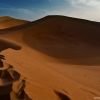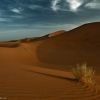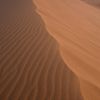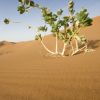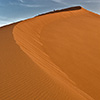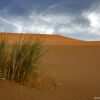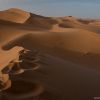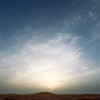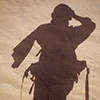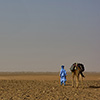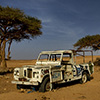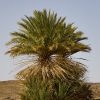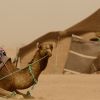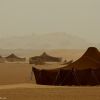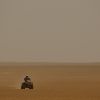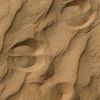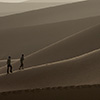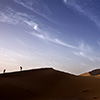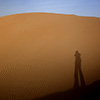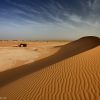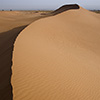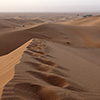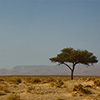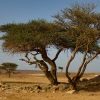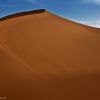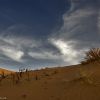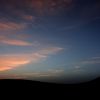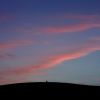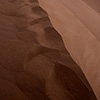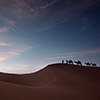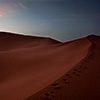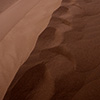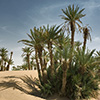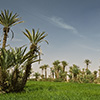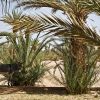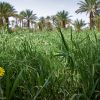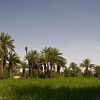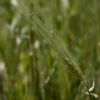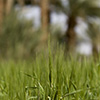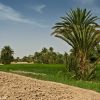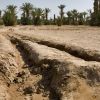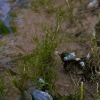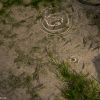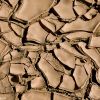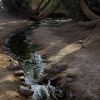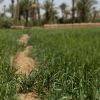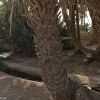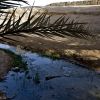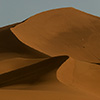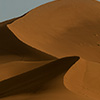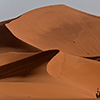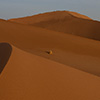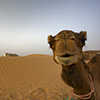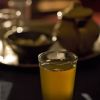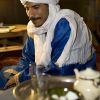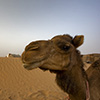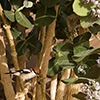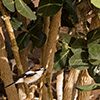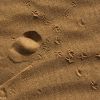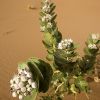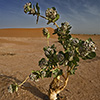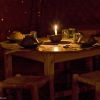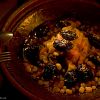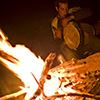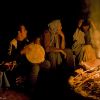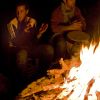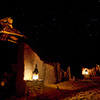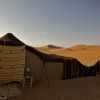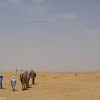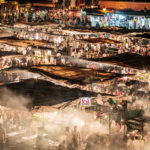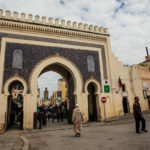Sand Blasted – The desert of Morocco
If you can see your hand in front of your face and it isn’t vanishing into yellow air; if the inside of your lungs doesn’t become dust crumbed and the sun doesn’t burn the last drop of water out of your body; if a camel’s back is not the reason of bruises and that you’re close to being emasculated, yes, then the desert can mean lots of fun… ;-)
In Morocco’s eastern interior land sand is ten a penny. In particular the mossy rocks at the Draa river valley, close to the still snow covered mountains of High Atlas, seem to fancy having a battle with with the desert. Right there the subterranean brooks take a good run-up to survive the heat, to make it supplying picturesque oases with essential water.
The fight of vegetation against sand, of humidity against heat starts all over again every day anew. Although, the stage win can always be a surprise. Even if in the morning you’re faced with sand blasted in your eyes by sand storm forces 6 to 7, in the afternoon the sun can take over and the weather is can be calm again. Suddenly you see your own hands again and can get rid of the reddish ultrafine sand powder that’s in your clothes and in ALL your body orifices. In suchlike situations oases mean yet another welcome hideaway. Not only you find water and verdancy, but palms & co. are also an excellent bastion against any dust attack rolling towards you.
When the wind slackens the reins it doesn’t take much time and the first camel riders, bikers and jeeps appear; each of them have tourists on board, who are searching their desert adventure in the most different ways. To make such dreams come true, Morocco has two major desert areas on offer: the dune field Erg Chebbi near Merzouga and area around Zagora and Mhamid, close to the dunes of Erg Chegaga. Actually both area don’t have that much differences in all things called tourism, however many locals say that Merzouga is not only more touristy, but also better developed. There’s no accounting for taste, but I think that the Erg Chegaga dunes are more spectacular than the Erg Chebbi ones. Those who fancy to have a ride to Zagora and Mhamid also have to sit out a 8-10 hour bus ride, that’s the time distance to Marrakech. Shortly after arriving mindful observers will notice, that for the locals the desert is their source of income #1. Unfortunately “industry” is often the only appropriate title for all tours offered, such as rides to the dunes and desert camps. At the latest when your guide answers a call, you’ll immediately be kicked back into presence by Russian trash techno ring tones. Already the picture of having cell phone reception in the middle of nowhere means an abrupt ending for any desert romanticism and Sahara dreams.
Many of the desert photos shown here I deliberately took in a darker way, to accentuate the marvellous play of light when the evening sky is arriving or the first sunbeams conquer the night sky. Their satmosphere shall be like as if you would sit on a dune’s ridge all alone. Only you and the sunset, above you only the stars, getting ready to conquer the light flooded sky. You still feel the warm ground and the smell of the sand, which you let trickle through your fingers like a small child…
Every once in a while there’s life in the wasteland, an oasis appears. Suddenly there are some palms, if not to say an entire palm copse standing in an area dominated by rocks, rubble and burning heat. Mhamid itself is an oasis as well, but principally used for agriculture such as growing cereals.
Though, when driving to the Erg Chegaga dune field, your eyes will be pleased by much more impressive. It is really way-out to find a brook where actually no water is able to hold its position. To boot it’s flowing. Your jaw will drop even more when spotting small fishies and frogs in there. In the end you’ll be flabbergasted by a life form whose life heavily depends on the other two life forms: a parasite, a fish leech. An anomaly of life, far away from the next permanent water supply.
One of the most beautiful contrasts between desert, rocks and vegetation you can find along the road from Agdz to Zagora. In particular at the sunset time that huge continuous palm copse along Draa river looks like a unique painting; its high count of Kasbahs are the dot on the i.
Quite often desert tours are connected with an overnight stay in one of the camps. The by far most frequented is the camp at the foot of the Erg Chegaga dune field, the highest sand dunes in Morocco. Next to the main camping site there are other camps for bikers, quad riders and sand borders. Some of them, especially the motorized people, make a nuisance of themselves in the area, since they prefer making noises and cutting furrows the beautiful dunes. The more you get rid of them, the more you’ll find quiet, loneliness and atmosphere such a place deserves.
The survival strategy in the desert is easy; either you’re hiding yourself from the sun, or battening down all hatches while being highly toxic. Like all others deserts, the Sahara is not only wasteland, it’s more or less naturally covered by lots of plants. They are often harmlessly looking and very beautiful to some extent, though due to its ingredients those tiny plantlets are definitely sly old dogs. Sometimes only touching them is enough to cause you a major problem… And usually you won’t find the next doctor around the corner. The third strategy to survive has a human origin and answers to the name of “blue”, respectively Homme Bleu. Those men wrapped up in indigo blue cloth are THE desert guides par excellence. Many of them know the desert like the back of their hand. Why Indigo? That question is quickly answered. Indigo absorbs the dangerous UV rays; it filters the sunlight and can be seen like the effect of conventional sun blocker. Another plus factor is that you’re not really sweating when wearing such a cloth; that’s good for the body’s water balance.
The truly magic times are usually sunrise and sunset. Usually that is the case in Morocco as well, but there’s a sour note though. The sun doesn’t disappear big and red behind the horizone; quite often the Sahara dust in the atmosphere fades out the sun until it is nothing but a greyish shining disk. In Morocco you will rarely see the amazing colours that can be watched at Wadi Rum (Jordan) or in Sossusvlei (Namibia). The reddish sidelight has often no chance to win the fight against a curtain of dust. Desert fans will quickly be disenchanted, while for others that first contact with the desert is surely the best they’ve ever seen, so far. That surely also explains the high count of enthusiastic travel reports. I took my photos on only one evening, respectively morning. Fortunately then light was brilliant, but on all other days the light was quite a low performer…
To me it is very important to give my readers the widest possible impression of the countries I’ve travelled. Sometimes that also means to mention negative points, since it is actually not necessary to experience certain things twice. As written before, the desert tours are a business, are in fact kind of an industry. Upon the recommendation of Edith Kohlbach I’ve chosen the Mhamid based Sahara Services agency for my desert trip. Due to knowing Arabic and speaking to locals I found out about following:
- Ok, we are living in Capitalism, but to pay a camel guide less than 5 Euro a day, while making a killing by ripping off 100 Euro per desert day is just humanitarianly crude.
- Once you’re travelling alone you’ll be charged by an extra of 50 Euros. That wasn’t the case in all emails we had before, wasn’t even the case when explicitly asking if there is a possible surcharge. But then travelling in a group, not alone, that clashes each other. Except the jeep transfer to Erg Chegaga and the short camel ride I had, I was always part of a group. Groups are fine, you can meet a lot of cool new people. But in case of Sahara Services you have to pay for that while you’re getting the same assembly line treatment everybody else gets. And the others DON’T have to pay a surcharge for that.
- For the ride to the Erg Chegaga dunes every participant gets an own jeep with an own driver. That is pretty self-contradictory since every jeep is polluting the desert for about 2.5 hours to bring after all only one participant to the dune field. In that case grouping people would have made sense in both ways, economically and environmentally. By the way, the drivers have to have their own jeeps and they get paid unimportantly more than the camel guides.
- Women travelling alone quickly become the target of the boss himself. The problem: Abdoul’s activities to hook up a girl doesn’t really know a limit…
- The water bottles handed out at the begin of your desert trip are rationed per day and per head. The problem: nobody tells you that. If your camel guide forgets about the bottles or (since you’re part of a group now…) too many people drink from “your” water bottles, then in the end you have to buy new water. I think it’s obvious what kind of price tag that water acquisition has…
- Same about the desert toilet, a place where lots of fellow Central Europeans forget about hygiene, forget about flushing. Due to my own potty training I flushed the white bowl with 2-3 (small!) buckets of washwater. Soon somebody showed up and charged me 100 Dirhams, due to “excessive water usage”.
- In general the camels don’t have a good saddle. Well, using the word “saddle” for a blanket thrown over the humps is slightly exaggerated. Even if the camel ride is short, the rubbing humps show no mercy. Everything’s possible, reaching from tensions to bruises and sore thighs.
- The recommendations of Edith Kohlbach have to be seen against of she doing the PR for Sahara Services. She’s surely not doing that due to charitable reasons.
- As for the town of Mhamid, people seem to use the region around the town as waste disposal. Near Mhamid there is an area where you can find plastic bags every 10cm like small bushes. It’s like the single jeep transfer to Erg Chegaga, they don’t really care about environment and ecological ressources.
- On the other hand Sahara Services helped me to find a hotel in Marrakech. Due to European’s having a long Easter weekend and Moroccans having a long Prophet’s birthday weekend, the hotel situation was really tight. Sahara Services unbureaucratically helped me to find a place to stay.
Understandably lots of people want to be on the bright side of life. So they book in advance using email and internet. Regarding that matter Sahara Services is really good… Personally my decision, who to book for a desert tour, would have looked different, if I would have known about the facts mentioned above. I wouldn’t have cancelled the desert tour itself, but I would have looked for a different agency offering desert tours and overnight stays. In view of the large quantity of desert guides and agencies my search would have ended a) quickly, b) successfully and c) most probably would have supported the locals much more than capitalists.
